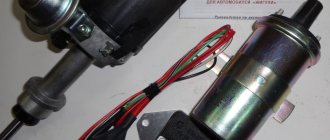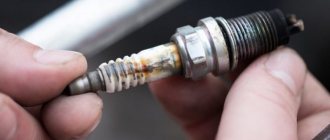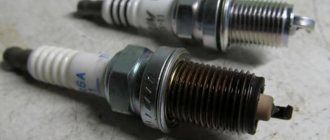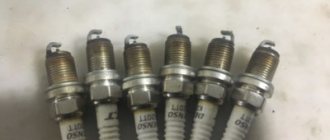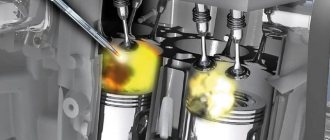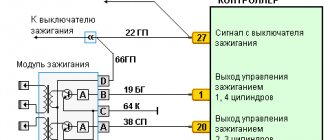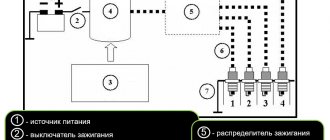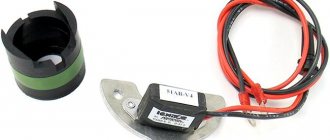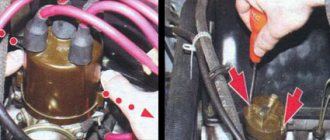How to choose the right spark plugs for a VAZ
When choosing the best spark plugs for a VAZ engine, you should be guided by the parameters of the car and engine:
- Heat number. If a spark plug is approved for use on a specific car, then it will be suitable in terms of its thermal characteristics. Small deviations play a seasonal role and depend on the owner’s driving style.
- Geometric dimensions - diameter and thread pitch, length of the threaded part of the body. Protrusion or recession of the electrode area into the material of the block head is not allowed.
- The nominal gap between the electrodes can be adjusted. The spark plug will operate uninterruptedly at the factory-set value.
- The wrench size is of secondary importance and affects the applicability of the existing tool. It is always safer to choose the size that matches the factory size.
- The sticking out of the electrodes has an indirect effect; the heat rating depends on it.
You should not get carried away with high-reliability spark plugs that have two to four side electrodes instead of the standard one. This will do little, but massive protruding parts can shield the working gap from the mixture flows in the cylinder, which will worsen the conditions for uninterrupted ignition.
All kinds of “patented” products mentioning plasma ignition, annular gap or with miniature prechambers are mostly advertising gimmicks; they will not work normally in all modes. It is better for the engine not to mess with such devices.
With contact ignition
Contact battery ignition was used on outdated engines with a carburetor and 8 valves, for example, VAZ models 2106, 2107 and the like. Such products have a reduced spark gap, since the power of the simplest ignition system is small, the secondary voltage cannot reach this value. The situation is saved by the low compression ratio of older engines. The higher the pressure at the end of the compression stroke, the more difficult it is to break through the spark gap.
Small size and power do not seem to be an obstacle to the operation of the motor. The engines are not particularly economical or environmentally friendly; the carburetors prepare a fairly rich mixture, which is not difficult to ignite even with a weak spark.
With contactless ignition system
For the first time, the contactless system was used on models 2108, 2109, early 2110, then engines of the classic family with Solex carburetors capable of preparing a lean mixture were equipped with such devices. The distributor with a Hall sensor worked on an electronic switch, which developed significant power in the secondary circuit; the voltage was enough to break through the increased spark gap at high pressure. It was possible to install more modernized candles or increase the gap in the classic ones.
For injection engines
With the advent of electronic fuel injection systems, ignition power has increased even further. The distributor has failed. Ignition modules with several coils or blocks for each spark plug without high-voltage wires have appeared. Requirements for parts have changed, including radio interference suppression. Such devices are not interchangeable. The injector can prepare lean and ultra-lean mixtures, while the engine maintains uniform thrust, which a carburetor cannot do.
Injection engines were installed on VAZ models 2114, 2115, 21074, which have 8 valves, and 2112 - 16 valves. These are modern units for their era, so choosing candles for them will not be difficult - many imported analogues are suitable.
VAZ 2107 | Replacement and maintenance of spark plugs
The engine is equipped with spark plugs of type A14DVR or LR17YC.
You will need: a special spark plug wrench “21” with a rubber ring inside, round wire probes.
1. Remove the spark plug tip with the seal without disconnecting the high-voltage wire from the tip.
2. Using a spark plug wrench, unscrew the spark plug and remove it from the cover well (the spark plug remains clamped in the rubber ring of the key).
3. If cracks are visible on the spark plug insulator, the threads or spark plug electrodes are damaged, replace the spark plug.
Pay attention to the carbon deposits that cover the bottom of the candle. If light brown carbon deposits evenly cover the spark plug with a thin layer, it does not need to be cleaned, since it does not affect the operation of the ignition system. If there is no carbon deposits at all, it means that the engine is running on a lean mixture or with an increased ignition timing. If the spark plug is covered with a matte black soot that is easily erased, this indicates that the engine is running on an over-rich mixture. Shiny black carbon deposits indicate that too much oil has entered the engine cylinder. Black carbon deposits must be cleaned off with a sandblaster, and then the spark plug must be blown out with compressed air. You can clean carbon deposits from a candle with a stiff hair brush, after first immersing the candle in gasoline for 20–30 minutes. It is not recommended to clean off carbon deposits with sharp metal objects: they will leave scratches on the spark plug, which will accelerate the carbon formation process. If the elements of the engine control system are in good working order, oil consumption is normal, and the spark plugs are constantly covered with a black coating, then the spark plugs are faulty, regardless of their service life.
4. After cleaning the carbon deposits, check the gap between the spark plug electrodes. Check the gap only with a round feeler gauge, since when checking with a flat feeler gauge, the depth of the recess on the side electrode, which is formed during the operation of the spark plug, will not be taken into account. The gap should be 0.85 mm. If the gap differs from the specified value, adjust it by bending the side electrode.
It is prohibited to bend the central electrode - this will lead to cracks in the insulator and failure of the spark plug.
5. Screw the spark plug into the socket by hand until it stops and tighten with a wrench. Do not tighten the spark plug too much, the tightening torque of the spark plug is 31–38 N·m (3.1–3.8 kgf·m).
6. Place the tip on the spark plug and install its seal so that the lower edge of the seal is placed on the flange of the hole in the cylinder head cover.
It is recommended to replace all spark plugs after 10–15 thousand kilometers, regardless of their condition. If one spark plug fails, it is recommended to replace the entire set, regardless of the operating mileage. It is not recommended to use spark plugs of different brands on the engine at the same time. Gone are the days when the question of which spark plugs to buy was irrelevant and it was possible to purchase only domestic ones and only the same model as on the car. Now on the shelves there is a huge selection of candles from almost all foreign manufacturers. And naturally, the “self-made” people immediately began to counterfeit them. In order not to buy a fake, first of all pay attention to the packaging: the quality of printing from real manufacturers is impeccable, but from counterfeit ones the contours of the drawings often do not match. If there is no packaging at all, further inspection of the candles makes no sense - there are no branded candles without it. Then inspect the candles. The central electrode must have a clear cylindrical shape, and its surface must be absolutely smooth. If there are defects on the electrode and, moreover, it is installed crookedly, this is a fake. The side electrode of a fake spark plug is often also welded crookedly, and its edges are oblique. For branded candles, the threads are made by knurling, so they are absolutely smooth. In fake candles it is cut and has small chips. The sealing ring of a real spark plug cannot be removed. On a fake one, it is either screwed into a thread or easily removed. The insulator of a real candle is absolutely smooth and shiny. A fake candle often has visible longitudinal seams from an inaccurately joined mold. Finally, the inscription on the insulator must be clear, even and neat. We also note that real branded candles cannot be cheap. Too low a price should alert you.
Sometimes, during intense acceleration with the engine spinning up almost to maximum speed, sharp jerks appear, perceived as blows. The spark plugs are to blame, although checking with a piezo tester (“pistol”) indicates their serviceability. The reason is that over time the spark plugs lose their tightness and a spark plug that works normally at low and medium loads misfires at high pressure in the combustion chambers. It is for this reason that it is not recommended to operate spark plugs for more than 15 thousand km without replacement.
Rating of the TOP 5 best spark plugs for VAZ cars
Copper-nickel spark plugs for VAZ cars of the “Standard” category are used on carburetor engines with a contact ignition system; their reliable service life does not exceed 10,000 kilometers.
Attention! These are products with a good reputation, so they are massively counterfeited. The rules for identifying the original can be found on the manufacturers’ websites.
| TOP | Candlestick pattern | Installed gap, mm | Thread diameter, mm | Length of threaded part, mm | Key size, mm | Order code | Price per piece, rubles, wholesale/retail |
| 5 | BRISK Classic L15Y | 0,7 | 14 | 19 | 21 | L15Y | 48/80 |
| 4 | HOLA S12 | 0,7 | 14 | 19 | 20,8 | S12 | 49/110 |
| 3 | NGK 7529 BP6E | 0,9 | 14 | 19 | 20,8 | 7529 | 98/150 |
| 2 | BOSCH W7DC | 0,7-0,8 | 14 | 19 | 20,8 | 0241235740 | 90/150 |
| 1 | DENSO 3043 W20EP-U | 0,8 | 14 | 19 | 20,6 | 3043 | 74/130 |
VAZ 2107 | Replacing spark plugs
Replacing spark plugs
Replacing spark plugs (after 30,000 km for leaded gasoline and after 50,000 km for unleaded gasoline)*
To determine further intervals for this check, see the appropriate sections of the vehicle's routine maintenance schedule.
Proper functioning of the spark plugs is vital to the correct and efficient operation of the engine. It is extremely important that the correct spark plugs for the given engine are installed in the vehicle (types of spark plugs are given in the Specifications at the beginning of this Chapter). If the requirements of the Specifications are met, the spark plugs should not require special attention in the intervals between the intervals of the current change of spark plugs; occasionally, cleaning of the spark plugs may be necessary, which should not be undertaken without special equipment, since otherwise the working ends of the electrodes can easily be damaged.
Models not equipped with a direct ignition system
1. Loosen the screws and remove the inspection cover in the center of the camshaft cover. 2. If the markings on the high-voltage spark plug wires are not visible, mark wires 1 through 4 in accordance with the numbers of the cylinders they serve (cylinder numbering is based on the distribution circuit). 3. Remove the wires from the spark plugs, pulling at the tip of the wire, not the wire itself, otherwise you may damage the wire terminal. After disconnecting all the wires, remove the O-ring from the distributor side of the cylinder head and move the wires to the side.
Direct Ignition Models
1. Disconnect the wire plug from the ignition unit on the flywheel side. 2. Remove the 4 screws securing the ignition unit to the top of the cylinder head. To do this you will need a hex wrench. 3. Where available, give the bolt and release the holding clamp of the block wires. 4. Where available, remove the bolt and disconnect the ground wire. 5. Carefully lift the ignition assembly while removing it from the spark plug tips.
| 1. To prevent dirt and foreign particles from entering the cylinders, it is necessary to remove dirt from the surface adjacent to the spark plug holes using a brush, vacuum cleaner or compressed air. | |
| 2. Using a spark plug wrench, a suitable tubular wrench, or a deep socket driver and extension, remove the spark plugs. Keep the replacement head strictly parallel to the spark plug; if the head moves or tilts to the side, the ceramic body of the spark plug can easily be damaged. | |
NGK 7529 BP6E
NGK 7529 BP6E
The spark plugs are universal and work across the entire range of temperatures and loads. They are resistant to the formation of deposits on the insulator, maintain the shape of the electrodes and the size of the gap. V-line technology ensures uninterrupted sparking. The copper rod in the central electrode removes heat, preventing overheating and damage to the insulator. The sealing of the housing is adequately done, the tightness is always at its best.
The gap for these spark plugs is 0.9 mm. This means that it is better not to use the product for a carburetor engine, only an injector.
The price for such quality is attractive and does not go out of the general range in the category.
The cost of candles is, on average, 150 rubles per piece.
Advantages and disadvantages
Good engine starting in any weather.
Sparking without interruption due to the use of new technology.
Excellent tightness.
Compliance price/quality.
There are often fakes on the market
BOSCH W7DC
BOSCH W7DC
Such candles have a working range that provides versatility of use. Sometimes they work on motors that require different temperature characteristics, which emphasizes the stability of German products.
The model is well assembled - it consists of a copper core and a shell with increased anti-corrosion properties. The gap here is 0.7-0.8 mm. The key size is 20.8.
One can note some optimism in setting the heat number in relation to old VAZ car engines.
The average cost for one candle is 150 rubles.
Advantages and disadvantages
High-quality assembly of the part.
Uninterrupted operation under heavy loads and low temperatures.
Price corresponding to quality.
The mixture may get on the spark plugs.
DENSO 3043 W20EP-U
DENSO 3043 W20EP-U
The best candles for this application took first place in the ranking. Experienced car service workers always recommend Denso products, knowing that the client will be satisfied. There will be no complaints about the candles; the products guarantee their operation regardless of the mode - idle or load.
There are some downsides - the U-Groove technology does not prevent you from driving on a cold engine at low speeds, soot formation is possible, the spark plugs are a little colder in heat rating than inexperienced drivers would like.
The gap on the product is 0.8 mm, therefore, it is not suitable for a carburetor engine.
The cost, on average, is 130 rubles per unit.
Advantages and disadvantages
Excellent quality, which is why spark plugs are installed on many cars from the factory.
Copper core ensures reliability.
Increased flame spread thanks to the U-shaped groove of the side electrode.
Soot quickly forms on candles.
VAZ 2107 | Checking and replacing spark plugs
3.11. Checking and replacing spark plugs
| GENERAL INFORMATION |
| You will need | |
| |
After 30,000 km.
When checking and replacing spark plugs, be careful - if the engine is hot, you can get burned.
Disconnect the wire from the “—” terminal of the battery.
A17DVR, A17DVRM, FE65PR, FE65CPR. Until 1988, spark plugs of types A17DV and FE65P were installed on the VAZ-2109.
When preparing for winter use, replace the spark plugs with new ones.
We recommend replacing spark plugs every 30,000 km, even if they are still in working order: old spark plugs can increase fuel consumption.
Regularly check the reliability of the connections of the high-voltage wires with the spark plugs, coil and ignition distributor.
Dirty insulation on high-voltage wires can cause current leakage, so wipe them with a rag whenever they become dirty.
Do not over-tighten the spark plugs - the ceramic plug insulator may crack, causing poor engine performance.
| EXECUTION ORDER |
1. When removing the tip from the spark plug, do not pull on the wire. If you need to remove all the lugs, first mark the high-voltage wires.
2. Clean the spark plug niches from dirt.
3. Carefully remove the spark plug using a special wrench. If the spark plug is hard to unscrew due to carbon deposits, drop WD-40 or Unisma into the threaded hole to avoid damaging the thread.
4. Inspect the spark plug. If there are cracks on the insulator, the threads or electrodes are damaged, the spark plug must be replaced.
5. Light brown carbon deposits, which evenly cover the lower part of the spark plug with a thin layer, do not affect the operation of the ignition system and do not need to be cleaned.
6. The absence of carbon deposits on the spark plug indicates either that the engine is running on a lean mixture, or that the ignition timing is incorrectly set, or that the spark plug brand does not match the engine type.
7. Shiny black deposits, indicating that oil has entered the engine cylinder, must be cleaned.
8. Check the gap between the spark plug electrodes (with a round feeler gauge only). The gap should be 0.7-0.8 mm. Check the gap only with a round feeler gauge.
9. If the gap differs from the specified one, adjust it by bending the side electrode.
